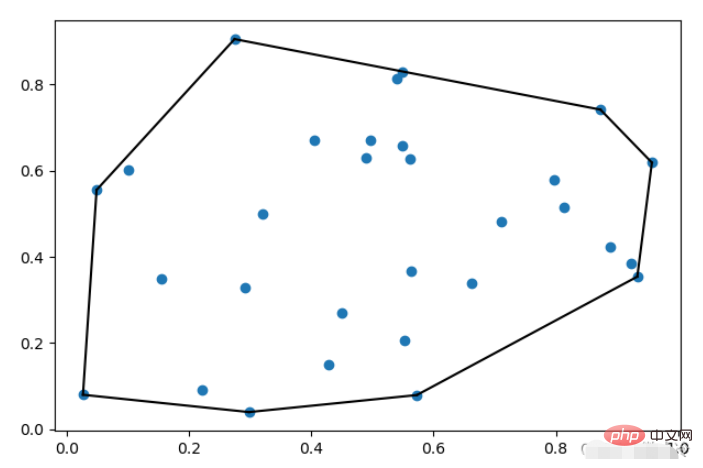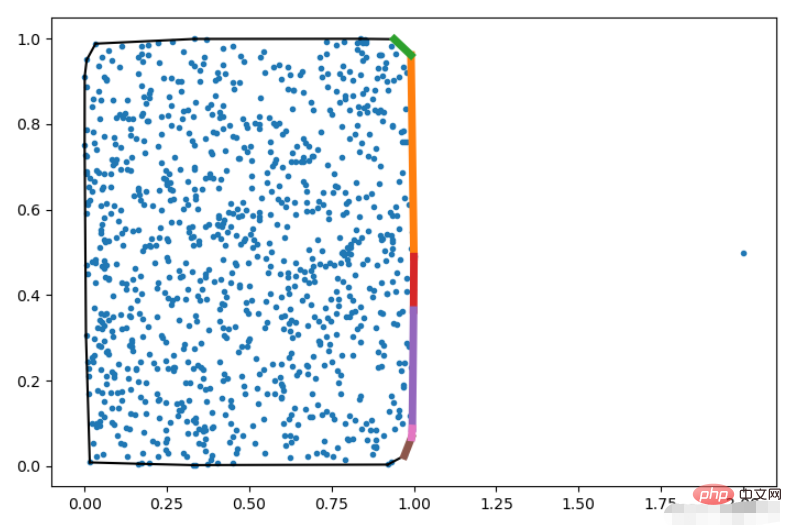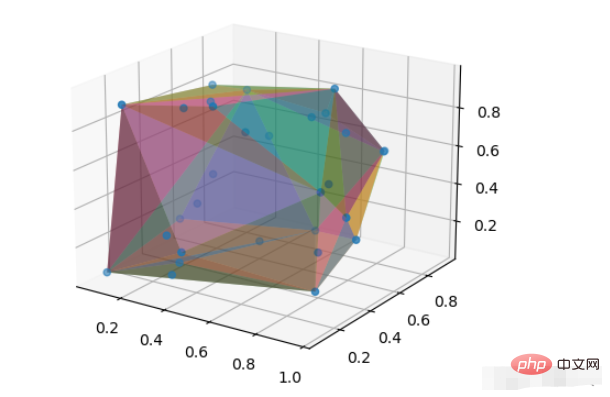Wie zeichne ich eine konvexe Hülle in Python?
ConvexHull
ConvexHull ist eine räumliche Klasse. Ihre Hauptfunktion besteht darin, die Kanten einer Menge von Punkten zu finden und eine konvexe Hülle zu erstellen. Der notwendige Initialisierungsparameter ist eine Punktmenge, das Punktmengenformat ist ein Array von n×m Dimensionen, n ist die Anzahl der Punkte in der Punktmenge und m ist die Dimension des Punktes.
from scipy.spatial import ConvexHull
import matplotlib.pyplot as plt
import numpy as np
pts = np.random.rand(30, 2)
hull = ConvexHull(pts)
plt.plot(pts[:,0], pts[:,1], 'o')
for i in hull.simplices:
plt.plot(pts[i, 0], pts[i, 1], 'k-')
plt.show()wobei simplex die Seriennummer des Indexpunkts ist. Der Effekt nach dem Zeichnen ist wie folgt: „Inkremental“ ist ein boolescher Parameter .
Die spezifischen Parameter von qhull_options können in qhull angezeigt werden. Nachfolgend wird nur QG demonstriert. 
pts = np.random.rand(1000, 2)
# 添加一个观察点
pts = np.vstack([pts, np.array([[2,0.5]])])
hull = ConvexHull(pts, qhull_options='QG1000')
plt.plot(pts[:,0], pts[:,1], '.')
for i in hull.simplices:
plt.plot(pts[i, 0], pts[i, 1], 'k-')
for i in hull.simplices[hull.good]:
plt.plot(pts[i, 0],pts[i, 1], lw=5)
plt.show()pts = np.random.rand(30, 3)
hull = ConvexHull(pts)
ax = plt.subplot(projection='3d')
ax.scatter(pts[:,0], pts[:,1], pts[:,2])
for i in hull.simplices:
ax.plot_trisurf(pts[i, 0], pts[i, 1], pts[i,2], alpha=0.5)
plt.show()Der Alpha-Parameter wird verwendet, um die Transparenz der dreieckigen Oberfläche anzupassen, sodass die Punkte innerhalb der konvexen Hülle durch die konvexe Hülle sichtbar sind.
Der Effekt ist wie folgt
 ConvexHull-Attribut
ConvexHull-Attribut
Das Konzept eines Simplex wurde bereits eingeführt, das heißt, die aus der konvexen Hülle bestehende Figur ist ein Simplex. Im zweidimensionalen Fall ist die konvexe Hülle von Liniensegmenten umgeben. Im dreidimensionalen Fall ist die konvexe Hülle von Ebenen umgeben durch Hyperflächen. Da der Begriff der Hyperfläche keine Grenzen kennt, wird die konvexe Hüllenfläche mit Eckpunkten und Kanten im Folgenden als Simplex-Hyperfläche bezeichnet.
Häufig verwendete Attribute in der ConvexHull-Klasse sind wie folgt
Punktsatz, umgeben von einer konvexen Hülle

- Nachbarn super Oberfläche Indizes benachbarter Hyperflächen
- Gleichungen Parameter von Hyperflächengleichungen
- Beispiele für Hyperflächengleichungen im dreidimensionalen Fall sind wie folgt, das heißt, jede Hyperfläche hat 4 Parameter
>>> hull.equations array([[-0.5509472 , 0.72386104, -0.41530999, -0.36369123], [-0.26155355, 0.16210178, -0.95147925, 0.02022163], [-0.99132368, -0.0460725 , 0.12310441, 0.045523 ], [-0.98526526, -0.07170442, 0.15527666, 0.04749854], [-0.15900968, -0.98529789, -0.06248198, 0.13294496], # .......Nach dem Login kopierenDas obige ist der detaillierte Inhalt vonWie zeichne ich eine konvexe Hülle in Python?. Für weitere Informationen folgen Sie bitte anderen verwandten Artikeln auf der PHP chinesischen Website!

Heiße KI -Werkzeuge

Undresser.AI Undress
KI-gestützte App zum Erstellen realistischer Aktfotos

AI Clothes Remover
Online-KI-Tool zum Entfernen von Kleidung aus Fotos.

Undress AI Tool
Ausziehbilder kostenlos

Clothoff.io
KI-Kleiderentferner

AI Hentai Generator
Erstellen Sie kostenlos Ai Hentai.

Heißer Artikel

Heiße Werkzeuge

Notepad++7.3.1
Einfach zu bedienender und kostenloser Code-Editor

SublimeText3 chinesische Version
Chinesische Version, sehr einfach zu bedienen

Senden Sie Studio 13.0.1
Leistungsstarke integrierte PHP-Entwicklungsumgebung

Dreamweaver CS6
Visuelle Webentwicklungstools

SublimeText3 Mac-Version
Codebearbeitungssoftware auf Gottesniveau (SublimeText3)

Heiße Themen
 Wie löste ich das Problem der Berechtigungen beim Betrachten der Python -Version in Linux Terminal?
Apr 01, 2025 pm 05:09 PM
Wie löste ich das Problem der Berechtigungen beim Betrachten der Python -Version in Linux Terminal?
Apr 01, 2025 pm 05:09 PM
Lösung für Erlaubnisprobleme beim Betrachten der Python -Version in Linux Terminal Wenn Sie versuchen, die Python -Version in Linux Terminal anzuzeigen, geben Sie Python ein ...
 Wie kann ich die gesamte Spalte eines Datenrahmens effizient in einen anderen Datenrahmen mit verschiedenen Strukturen in Python kopieren?
Apr 01, 2025 pm 11:15 PM
Wie kann ich die gesamte Spalte eines Datenrahmens effizient in einen anderen Datenrahmen mit verschiedenen Strukturen in Python kopieren?
Apr 01, 2025 pm 11:15 PM
Bei der Verwendung von Pythons Pandas -Bibliothek ist das Kopieren von ganzen Spalten zwischen zwei Datenrahmen mit unterschiedlichen Strukturen ein häufiges Problem. Angenommen, wir haben zwei Daten ...
 Python Hourglass Graph Drawing: Wie vermeiden Sie variable undefinierte Fehler?
Apr 01, 2025 pm 06:27 PM
Python Hourglass Graph Drawing: Wie vermeiden Sie variable undefinierte Fehler?
Apr 01, 2025 pm 06:27 PM
Erste Schritte mit Python: Hourglas -Grafikzeichnung und Eingabeüberprüfung In diesem Artikel wird das Problem der Variablendefinition gelöst, das von einem Python -Anfänger im Hourglass -Grafikzeichnungsprogramm auftritt. Code...
 Wie lösten Python -Skripte an einem bestimmten Ort die Ausgabe in Cursorposition?
Apr 01, 2025 pm 11:30 PM
Wie lösten Python -Skripte an einem bestimmten Ort die Ausgabe in Cursorposition?
Apr 01, 2025 pm 11:30 PM
Wie lösten Python -Skripte an einem bestimmten Ort die Ausgabe in Cursorposition? Beim Schreiben von Python -Skripten ist es üblich, die vorherige Ausgabe an die Cursorposition zu löschen ...
 Python Cross-Platform Desktop-Anwendungsentwicklung: Welche GUI-Bibliothek ist die beste für Sie?
Apr 01, 2025 pm 05:24 PM
Python Cross-Platform Desktop-Anwendungsentwicklung: Welche GUI-Bibliothek ist die beste für Sie?
Apr 01, 2025 pm 05:24 PM
Auswahl der Python-plattformübergreifenden Desktop-Anwendungsentwicklungsbibliothek Viele Python-Entwickler möchten Desktop-Anwendungen entwickeln, die sowohl auf Windows- als auch auf Linux-Systemen ausgeführt werden können ...
 Bieten Google und AWS öffentliche PYPI -Bildquellen an?
Apr 01, 2025 pm 05:15 PM
Bieten Google und AWS öffentliche PYPI -Bildquellen an?
Apr 01, 2025 pm 05:15 PM
Viele Entwickler verlassen sich auf PYPI (PythonpackageIndex) ...
 Wie kann ich große Produktdatensätze in Python effizient zählen und sortieren?
Apr 01, 2025 pm 08:03 PM
Wie kann ich große Produktdatensätze in Python effizient zählen und sortieren?
Apr 01, 2025 pm 08:03 PM
Datenkonvertierung und Statistik: Effiziente Verarbeitung großer Datensätze In diesem Artikel werden ausführlich das Umwandeln einer Datenliste in eine andere enthält ...
 Können Python -Parameteranmerkungen Zeichenfolgen verwenden?
Apr 01, 2025 pm 08:39 PM
Können Python -Parameteranmerkungen Zeichenfolgen verwenden?
Apr 01, 2025 pm 08:39 PM
Alternative Verwendung von Python -Parameteranmerkungen in der Python -Programmierung, Parameteranmerkungen sind eine sehr nützliche Funktion, die den Entwicklern helfen kann, Funktionen besser zu verstehen und zu verwenden ...






